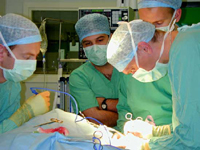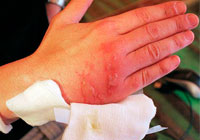Splezenka is the second mother for the body. One of the functions of the spleen is to assign the nutrient substance, in its reception and further transmission. What diseases may chase this body? And what is splenectomy? More details you will learn from this article.
Content
Mysterious organ
One young talented doctor, subsequently the famous writer, subscribed under his first literary experiments as follows: «Man without spleen». The pseudonym turned out to be funny: who is it is unknown, without which this person is also unclear. After all, in those times, when Anton Pavlovich Chekhov practiced, Splezenka puts representatives of all schools and trends in medicine. Probably, this mysterious body was interested in Chekhov-doctor.
What role the spleen is performed in the human body, until recently it was unclear. According to my student memories, medical medical teachers spoke on her function very carefully and only allegedly. Why? The fact is that, as medical practice showed, the body could well do without this organ. There were situations when it had to delete. For example, if, as a result of the injury of belly or injury, severe bleeding began, they were removed, and the man continued to live peacefully without any tangible complications.
 With pair authorities in such a situation everything is clear. After removing one of «twins», The second function copes with the function. This refers to the kidneys, easy. But how can I remove the organ if he is one? It is impossible, for example, without replacing, remove the heart or liver. And why the spleen can?
With pair authorities in such a situation everything is clear. After removing one of «twins», The second function copes with the function. This refers to the kidneys, easy. But how can I remove the organ if he is one? It is impossible, for example, without replacing, remove the heart or liver. And why the spleen can?
So what is the role of the spleen in organismizeline in the middle of the last century there was a guess that outdated red blood cells disintegrate in the spleen. But it seemed strange: why the body would distinguish the whole body under the erythrocyte cemetery? After all, the body is a very economical system. There was an ambiguity. And only when immunology began to develop a rapid pace, it turned out the true role of the spleen in the body.
Spleen - an unpalaring body. It is small (on average 8-15 cm long, width - 6-9 cm). Located in the abdominal cavity, in the left hypochondrium, symmetrically liver. Spleen artery from which this body gets blood, moves directly from the very main artery of the body - aorta, and already from the spleen on the venous vessels blood goes into the liver. Such a location on the trunk paths of blood flow speaks of communication of the function of the spleen with blood composition. Currently, it is known that the spleen performs immunological, filtration and hematopoietual functions. Takes part in the exchange of substances - in particular, iron and proteins. As you can see, the role of the spleen is not so small. But at the same time it is not a vital organ. Are there any implications and what are blood diseases for diseases or disposal removal?
The whole spleen is permeated with connective tissues. Between them there is a spleen fabric - pulp (flesh). In vessels pulp just crowded blood cells - red blood cells, lymphocytes, macrophages. Basically, the spleen consists of a red pulp, in which there are splashes of white pulp in the form of spherical clusters.
The function of the Red Pulp - the destruction of the erythrocytes and other blood cells, for example, narrow platelets. In addition, she deposits blood and iron, sending them to the bloodstream as needed. Participates in the synthesis of bile pigments. This is happening. The hemoglobin is released from the dead or defective erythrocytes and is recycled with macrophage blood cells (large eaters) spleen with the release of iron and the formation of precursors of biliary pigments.
White spleen pulp - branch of immune system. In a white pulp along the periphery of each «ball» T-lymphocytes are rushed from another immune body - a fork gland. And in the center of the plots of white pulp breeding in lymphocytes and begin to produce antibodies, which from the spleen enter blood. Interestingly, in the process of intrauterine development in the child's spleen, other blood cells are multiplied - red blood cells. Then this process (erythropoez) in the spleen fades.
Diseases of the spleen
Can the spleen cheer? Own diseases of the spleen are found not often. So I will only list some of them.
Siezen's heart attack. It turns out, it happens not only in the heart. Focal samples of spleen tissues during thrombosis of spleen blood vessels are found. The diagnosis of this state has great difficulties.
Occasionally and tuberculosis deseen.
The injuries of the spleen are injuries - injuries, breaks, which is fraught with strong bleeding (in these cases, not to force an urgent operation).
But more often the spleen is amazed again, with various infections. The fact is that it performs and filtering function - delays microbes in itself. But not always copes with them. In the pathological process, the spleen is involved in such infections as infectious mononucleosis (viral disease, affecting blood lymphocytes), viral hepatitis, malaria, brucellosis, typhoid and others. With sepsis (blood generation) there is even an abscess of the spleen. In all these cases (except the abscess at which surgical intervention is required) is treated with the main infectious disease. And the spleen after that is restored itself.
Splenectomy
- If, as a result of injury, the spleen is injured or rupture, severe bleeding occurs. It's dangerous for life. And the sewing soft fabric of the spleen is almost impossible - the threads cut it up, do not hold.
- The second case is hereditary or acquired diseases, accompanied by a decrease in platelets (hereditary enzympathy, autoimmune diseases, etc.). At the same time, a tendency to subcutaneous hemorrhages. A huge numerous bruises formed with the slightest injury and even without it. In severe cases, the tendency to bleeding becomes dangerous. In situations where conservative treatment does not help, resort to the removal of spleen (splenectomy). If you remove the spleen, the platelets will live longer (although they are less complete), and their amount in the blood will increase. At the same time, strong subcutaneous hemorrhages will occur less often. They will protect the platelets accumulated in the blood.
- The spleen is removed and with its abscesses, but it meets much less often.
-
Since the spleen, as I said, the filtering body, then the tumor cells are delayed in the blood current. Therefore, if the tumor is affected by the adjacent organ (for example, the left kidney), then the spleen is removed prophylactically. It also happens that metastases are formed in the spleen - in this case it is necessarily removed.
Life after surgery
In principle, the spleen creates physicians significantly fewer problems than other organs. But so much nothing changes when it is removed? What are the consequences, illness that change in blood?
Rises blood platelets. If this happens in diseases with thrombopy (decrease in blood platelet content), then it is good. At the same time, after the operation, the number of platelets rises quickly, and then somewhat decreases. In other patients, the number of platelets as much as possible only by the 5-6th month after the operation. But it was noticed that even when formally, the number of blood platelets did not grow, bleeding still cut and decrease. But if the spleen is removed after injury and normal before the amount of platelets exceeds the norm, it is bad. Thrombosis may occur. So a long period after the operation is necessary to monitor the dynamics of the condition of the blood coagulation system.
After splenectomy, resilience resistance to infections. Especially to Pneumococcus. Therefore, at present, in front of such operations of patients sometimes vaccinated against pneumococcal infection. And after the operation, you must try not to stick. And to live, of course, you can. Without losing the quality of life.









